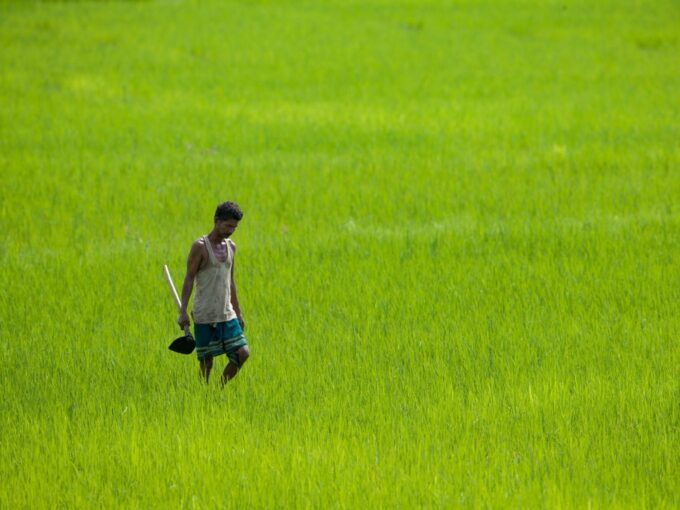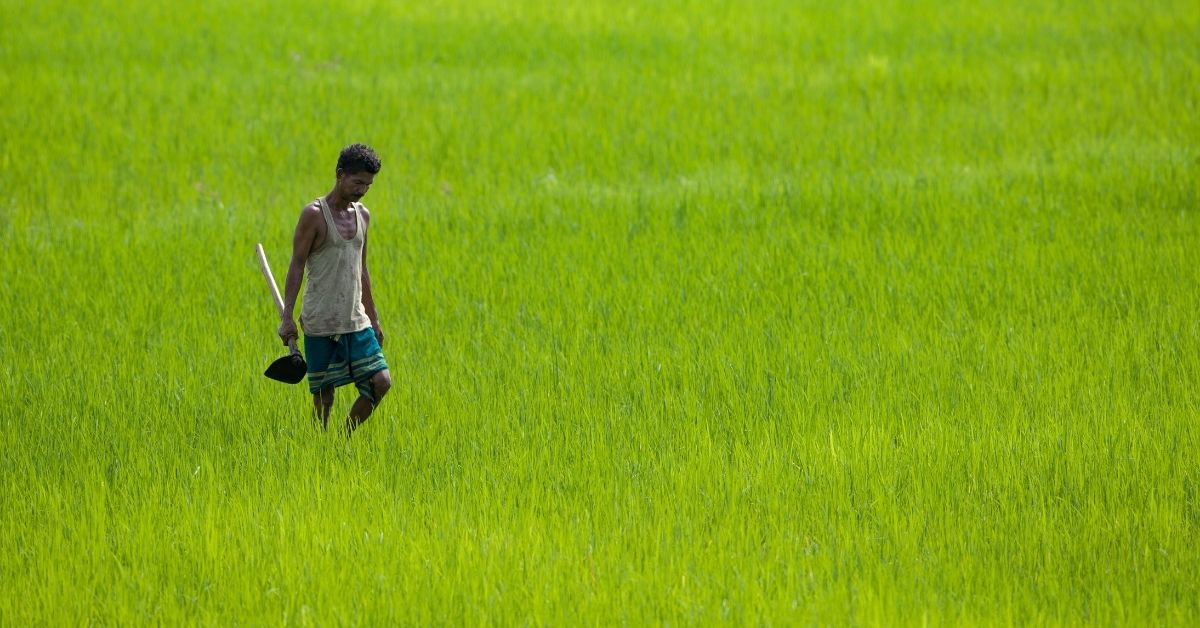
Repeal of farm laws have triggered debate on issues ranging from potential impact of repeal on small holder farmers to government’s future plan for reforms to investor’s concerns of investing in the sector. The new farm laws were brought by the government with an intent to make small holder farmers connect with the markets to drive much needed efficiency and transparency in the Indian food supply chain. This article is not a reflection on the impact of repeal of farm laws. This article attempts to answer the question, can we still achieve the intended outcome of improving farmer access to markets and farm economics, without necessarily tweaking the regulatory framework and if yes, how?
I think it is possible, with agritech interventions as they are growing and maturing, touching millions of farmers and winning their trust. Among the several agritech interventions that we see– “Agri fintech” – a term loosely used for use of technology to drive farmer and value chain financing, could be the one to significantly improve farm and farmer economics, as envisaged by the repealed farm laws. This article talks about the challenges and opportunities in the farmer and value chain financing and how agritechs are pivoting their model to grab a slice of the opportunity through their fintech tweaks.
Farmer’s access and cost of financing
Farmer’s access to institutional credit remains a constant challenge, despite year-on-year increase in budgetary allocation under Priority Sector Lending (PSL) for agriculture (approx. USD 220 bn for current FY). Approximately 30% farmers have access to institutional credit and balance 70% remain dependent on informal credit (annual interest rate ranging from 24 to 60% in informal credit against 7% under PSL).
The weighted average cost of capital (WACC) for an average Indian farm (about 1 hectare size) continues to be over 20% per annum, because of heavy dependence on informal high-cost credit. There are not too many businesses in the world which can make money if the WACC is over 20%, leave alone the small holder farmers in India. This is despite the fact that agriculture production has enough gross margins (Farm income – cost of (inputs + labour)) but margins gets eroded because of high interest cost that converts healthy EBIDTA to sick (usually negative) PBT. Unless we bring down the cost of credit by a significant margin, farm economics is unlikely to work on more than 85% of farms in India, which are small and marginal (area <2 hectares).
Three-Dimensional approach to deepen institutional credit
Bankers are wary of lending to farmers and other value chain players primarily because of lack of data, market linkages, high transactional cost of lending as well as recovery, along with unpredictable loan waivers by the state governments, from time to time.
Though technology cannot solve for loan waivers, it can certainly solve for other challenges faced by bankers in farmer financing through a “3D” approach – Data, Digitisation and Demand. Banker’s ability to lend can improve multifold with these 3D enabled through agritechs.
Data – Farmer identity and Farm identity are the hygiene data points that most bankers need in addition to several other data points for underwriting risk as discussed later. Though Farmer id seems solvable with Aadhar based framework; Farm id, continues to be a challenge because of lack of records/ updation/ digitisation and continued farm land fragmentation from one generation to another. These two data points also constitutes the foundation layer of Agristack, as proposed by recently released IDEA (Indian Digital Ecosystem for Agriculture) framework by Government of India.
Digitisation – to capture crop health, input usage, soil health, prices, quality of produce helps to build credit worthiness of farm as well as farmer which is key for risk assessment, monitoring and mitigation. Underwriting for bankers is difficult without digitization of the underlying assets be it crop in the field (for crop loans), commodity in the warehouse (for post-harvest warehouse receipt financing) or the cattle (for cattle loans). Unlike home loans or automobile loans – where asset quality /value don’t change that frequently and drastically; the asset quality and value, especially in crop loans can change in a matter of few hours /days with risks like unseasonal rain, pest attack, temperature shock etc. In fact, the emerging climate risk warrants for more granular and high-frequency digitisation approach to predict and mitigate climate risks for anyone lending to the sector participants.
Demand – Its proven that market inclusion with looped-in demand typically drives financial inclusion for farmers. Instead of conventional collateral-based financing approach used by bankers, cash flow-based financing for working capital needs becomes feasible with confirmed purchase orders from credible buyers. Confirmed demand and market linkages don’t just enable access to credit but also access to quality inputs and advisory, was one of the outcomes of the study that we undertook as part of Bharat Inclusion Imitative at CIIE.CO.
Farmers, in general, are more open to adopt innovations if purchase of farm output is assured in a given price range. The increasing organization of the demand side including the demand originating from institutional buyers, Horeca, ecomm, modern trade, mom and pop stores and D2C can pivot the supply-driven supply chain to demand-driven; enabling cash-flow based financing throughout the supply chain. Reforms or no reforms, this 180-degree pivot in supply chain is bound to happen, as two stakeholders which benefit the most in this process are – farmers and consumers – one who is growing and another one who is paying for the food; with other actors becoming incidental. I also believe distributed nature of demand and supply will not let anyone monopolise the supply chain, as feared by many.
The work on these 3Ds started in last decade around 2010-11 with emergence of agritech in India, much before the new farm laws came into picture. The digitisation revolution continues to gain momentum with over 1000 agri startups driving at least one of the three Ds; along with tailwinds coming from higher broadband / 4G access and smart phone penetration amongst farmers. The current agritech ecosystem has built enough depth to deliver on 3Ds for any crop / geography in the country; to ultimately make institutional financing amenable to millions of farmers and value chain players including dealers, traders, processors and distributors.
“Data and Digitisation” is driven by an array of startups using satellite imagery (such as SatSure, CropIn, RMSI, GreenSat, Dvara E Registry), weather stations (e.g: WRMS, Skymet), drones, sensors & IOT devices (e.g: Frugal Labs, Fyllo, Yuktix, Fasal), smart phones (e.g: Plantix, CropDoctor), spectroscopy (e.g: Agnext, Raav Tech, InfyuLabs), blockchain / tagging solutions (e.g: Innotrace, BWS, Tracex, SourceTrace) to capture hyperlocal weather parameters, land boundaries, soil health, plant health, quality parameters, traceability; which can help bankers assess, monitor and mitigate risks for underwriting loans.
“Demand” aggregation with assurance of purchase. price and payment are the key driver for timely loan collection and that is where market linkage startups like Innoterra, WayCool, NinjaCart, DeHaat, Agrowave, SMP Agro, Vegrow, Falca, Krishikan, Krishi Sahyog can play an important role by helping banks in efficient recovery of loans through tripartite agreement between farmers, bankers and buyers.
However, one must note that only 100% digital approach is unlikely to work especially with some components like farmer onboarding / KYC checks continue to be physical for near to medium term. This is another area where agfintech has the opportunity to deliver through local presence and partnership with local panchayat, CSCs, FPOs, NGOs and Village Level entrepreneurs. Agritech startups building direct to farm models for selling agri inputs (such as BigHaat, Agrostar, Unnati, Gramophone, Behtar Zindagi, Freshokartz) as well as agri input corproates (the ones selling fertilisers, seeds, agrochemical, machinery and feed) can use their field force for this purpose. In addition, rural tech startups like Hesa, Frontier Markets with strong first / last mile connect with farmers are also well paced in partnering with banks for efficient farmer onboarding.
Agritech pivoting to Agri-fintech
Agritechs such as Samunnati, Jai Kisan and NBFCs like Avanti have demonstrated that lending to farmers, FPOs and value chain players is doable at scale with a combination of smart data intervention, market linkages, partnerships and phygital approach.
This has nudged dozens of mature and established agritech players in market linkages, post-harvest, agri input and data centric models as exemplified above, to integrate financing / credit enabling as part of their core offering. In addition, many new agrifintech players like Agrifi, Gray Matter Technologies, Arboreum, IBISA have emerged trying to build their unique models and algorithms in agri-fintech as well as agri-Insuretech.
Post-harvest agritech players providing warehousing services such as Arya, Origo, Star Agri, NCML, NBHC, Ergos were the first one to pivot to enabling financing through partnership with banks or by launching their own NBFCs to lend against the warehouse receipts. Almost all of them are in the process of adding digital layer to the physical infrastructure to digitise the process of stock arrival, weighing, quality assaying, receipt and pledge generation to make loan disbursal efficient without bankers necessarily doing a physical visit / audit at the warehouse. Warehouse receipt financing is a classic used case of blockchain application as demonstrated by startups like Whrrl.
Livestock-tech startups including the ones in dairy, fisheries, aqua and poultry are not far behind in building fintech models for working capital loans for purchase of feed, equipments, processing etc. and asset loans (especially in case of cattle). Stellapps, Numer8, Aquaconnect, Livestoc, DGV are some of the players who are developing platforms to enable lending to livestock farmers.
Another emerging agri lending opportunity is “low capex – farm level asset” financing. Though digital-tech has enabled scale in agritech, I believe creation of farm assets with hard-tech / equipment-tech / Infra-tech solutions will be key to complement digital-tech solutions, to drive gross margins up through farm level value addition. Financing for low-capex processing sorting, grading, packing units, micro warehousing, cold rooms, bulk milk chillers etc typically costing less than USD 10,000 built at farm / near-farm is a large opportunity in waiting.
Farm level asset creation also has the potential to increase farm income and drive rural job creation. Farm level assets created by likes of S4S Technologies, Our Food, Inficold, Promethean, Ecozen, Takachar are good demonstration of the opportunity that is emerging. Though focus of agri-fintech has so far remained on working capital loans, it is a matter of time that we will see innovative solutions for term loans for farm asset financing.
Drivers, Enablers and challenges
There are four key drivers / enablers for agritechs pivoting to agri-fintech:
Farmer engagement and stickiness
Most Agritech who have built supply chain models (including farm to fork and direct-to-farm) typically have the opportunity to interact with farmers for less than 3-4 months in a year, at the time of sowing and then at the time of crop harvest. The engagement remains cyclical in line with typical Rabi-kharif crop cycles. Engagement is a bit more in case of vegetable farmers due to short duration crops and much higher in dairy / egg / fisheries supply chain because of daily throughput of the produce.
There is always a risk of loosing the farmer in a not-so-continuous engagement. This is why a platform approach becomes critical where you have the opportunity to engage with farmers at the time of selling inputs, buying output, providing advisory and facilitating financing. Financing is definitely one of the key anchors for driving perennial engagement as demonstrated by high stickiness of arhtiyas (local money lenders) with the farmers.
Also, startup’s ability to monetize farmer relationship increases multifold through facilitation of financing as part of the portfolio. As per my estimate, agritechs has the potential to earn on an average Rs. 10,000 per hectare of farm size per year through a platform approach including selling inputs, buying output, facilitating advisory, loans and insurance and at the same time, farmer earning and/or saving to the tune of about Rs. 30,000 per hectare in this process.
With gross margin pressures building up on most mature agritechs, along with likely fall in GMV-linked valuation; startups don’t have a choice but to vertically integrate or migrate into platform approach, on the back of financing solutions.
Bank’s partnership with agritechs
Most startups do not have reserves or capital to offer credit lines to the farmers, so they depend on NBFCs and banks for credit lines. There are only handful of NBFCs who have focused on agri financing and that is why bank’s partnership becomes key for scaling agri-fintech solutions. Agri fintech cannot prosper without active participation from mainstream banks.
In September’2021, State Bank of India came up with an RFP (request for proposal) for agritechs for becoming business correspondents for the purpose of sourcing, servicing and collection of agri and micro loans. This is a great step forward by the largest bank of the country partnering with tech players to reach out to a larger number of farmers reducing transactional costs in loan lifecycle.
There are other banks as well like Bank of Baroda, ICICI Bank, HDFC Bank, Kotak bank, Yes Bank, RBL bank and IndusInd Bank who are working with agri startups to build innovative ways of farmer financing. These pilots and partnership can go a long way in transforming PSL lending to agriculture, to the benefit of farmers and banking institutions.
Development of Agristack
Agristack – building and linking farm id to farmer id – could be gamechanger for facilitating almost instant access to farmers with financing as one of the biggest used cases. The bank’s transactional cost of few thousand rupees in acquiring / retaining a farmer and recovering farm loans can come down to few hundred rupees with Agristack implementation.
Several mini Agristacks developed by startups have demonstrated ease of farmer / value chain financing as one of the key used cases. For a change, many agri corporates are also in the process of digitizing farmer database and build their stacks as digital platforms for direct farmer connect (a case in point – nurture.farm initiative by UPL).
The government of India has also initiated development of Agristack under IDEA framework. We desperately need such open ag public data ecosystem to drive farmer financing at scale.
Growing equity base of agritech
Thanks to the exponential growth in capital infusion (approx. $ 2 bn in last 36 months out of cumulative $ 2.5 bn in last ten years) by VCs and strategics in agritechs, at least top 15-20 agritech startups have a strong equity base to give comfort to bankers for a leverage to lend further to farmers and value chain. Irrespective of their ability to launch and manage NBFC, startup’s balance sheet health can at least drive banking partnership for loan facilitations.
Despite many drivers and enablers for agri-fintechs as discussed above, there are three key challenges faced by these startups in driving fintech solutions:
Lack of alignment of agri fintechs with bank processes and systems
Banks find it challenging to accommodate the new age solutions coming from startups in their legacy systems and processes, for loan approval, processing, disbursement and collection. Banks face this problem not with just agritechs but also with fintechs. Also, most agritech startups do not provide holistic end to end solution. For example, the startup providing data for underwriting, does not play a role in loan recovery. This is where banks find it difficult to deal with multiple players for managing end to end loan cycle. Another challenge is that many banks do not see enough scale in terms of adding new farmer accounts and increase loan amount per farmer. Demonstration in scale of financing is key for banks to get excited about adoption of agri fintech solutions.
Need for guarantee funds
Majority of banks and financial institutions insist on guarantees while giving credit lines to agritech for further financing to farmers and value chain. The FLDG (First Loss Default Guarantee) typically range from 20% to 50% of loan amount. Most startups especially those undercapitalized find it hard to give FLDG. There are institutions like Rabobank who are launching guarantee funds to derisk funding for bankers. However, we need much more participation from DFIs, multilaterals, foundations in designing and launching guarantee structures.
Lack of inhouse banking talent
The talent for underwriting risk is missing amongst most mature agritechs who are pivoting to agrifintech. Some of them tried lending from their books but with little success. I don’t see this pivot working unless the startup hire a seasoned banker, as good as a co-founder. Unfortunately, post series B funding, founders are left with little room and intent to dilute further to accommodate a banker as a co-founder. Given the inevitability of this pivot, it is best to hire this kind of talent at the formative stage of the startup.
How big is agri-fintech opportunity?
It is difficult to put a specific number to agrifintech market potential, given many white spaces and blurred boundaries between occupational and personal loans given to farmers. Let me attempt some maths here.
The PSL lending to agriculture for the current financial year (FY) stands at USD 220 bn and is likely to inch closer to USD 250 bn in next FY. This includes loan given to farmers for asset purchase and working capital for agriculture and allied purposes. A part of these loans also goes for farmer’s personal use but there is no measured assessment of how much of PSL loan is used as personal loan by the farmer. Given institutional credit is reaching only one third of the farmers in India, theoretically there is need for USD 750 bn to cover all farmers. Let’s assume that one third of farmers either don’t need loans or are not credit worthy, one can peg back the farmer lending opportunity number to USD 500 bn.
In addition to the PSL opportunity, one can add untapped opportunity in post-harvest loan of USD 60 bn (assuming one fifth of staples and horticulture production, valued at approx. USD 300 bn, gets stored for few months in 2/3 cycles in a year) and another about USD 20 bn for allied industry for dairy, poultry, fisheries, aqua (assuming on an average one month working capital cycle for dairy and animal protein industry, valued at apprpx USD 200bn) and another USD 20 bn of asset financing opportunity for farm level infrastructure (some of it can be financed from the Agri Infra Fund of Rs. 1 lakh crores announced by the government).
This all adds up to about $600 Bn opportunity for agri fintech. All of it is not occupational loans as some of part of PSL lending is also personal loans as mentioned earlier. Nonetheless, it makes sense for agri-fintechs to cater to both occupational and personal loan needs of farmers to optimize the cost of farmer acquisition. I am not adding the opportunity available for financing in the downstream agri value chain as the nature of loan changes from farm / near farm loans to SME and corporate loans as one goes further down in the chain to processing, distribution and branding. Parametric insurance opportunity, not added to this number, is another big untapped opportunity as many insurance products can be sold along with financing solution.
To conclude, given the size of the opportunity with multiple tailwinds, it is imperative that agritechs are pivoting to agri-fintech despite some of the challenges as discussed above. I will not be surprised if some of the fintechs, conventionally focused on urban markets start looking at agri / rural fintech opportunity given fierce competition in urban fintech space.
Whether it is agri-fintech or fin-agritech which unfolds, one thing is for sure, banking partnership along with digitisation of the supply chain and implementation of Agtistack could just make this huge opportunity unleash, sooner than many of us expect and in that process make, agriculture a bit regulation-agnostic.
The author is an investor, mentor and board member with many foodtech and agritech start-ups in India and overseas. He serves as Venture Partner with Bharat Innovation Fund, co-founder of ThinkAg, chairman of FICCI task force for agri startups and strategic advisor to Innoterra. The views expressed in this article are personal.




![Read more about the article [Budget 2022] Govt to introduce EV battery swapping policy: FM Nirmala Sitharaman](https://blog.digitalsevaa.com/wp-content/uploads/2022/02/Featured-image-01-1643704133368-300x150.png)





